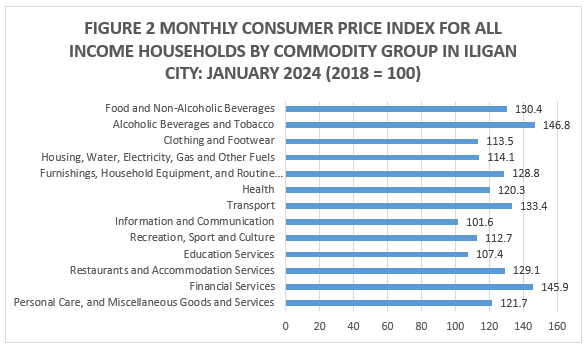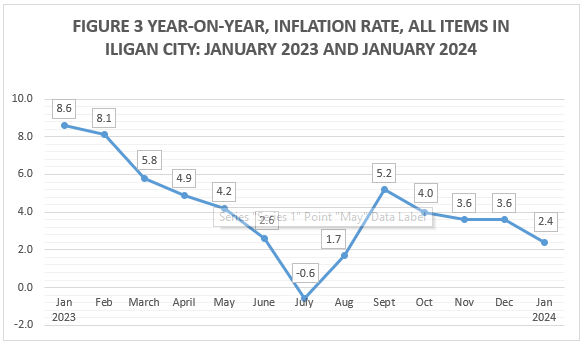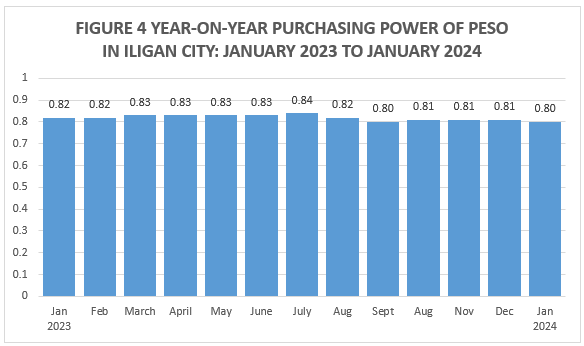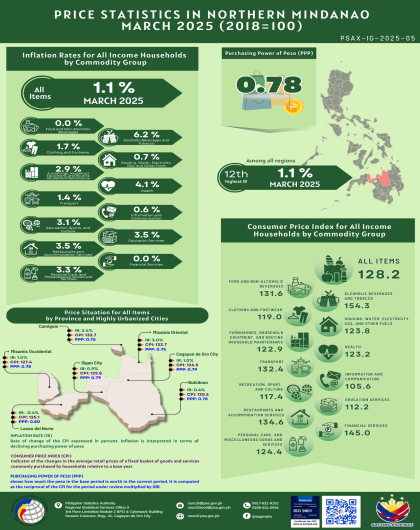Iligan City’s Consumer Price Index posted at 124.3 for January 2024, which implies that the price of one basket of goods was 24.3 higher than the price of goods in 2018.
The Consumer Price Index (CPI) is used as an indicator to measure the changes in the average retail price of one basket of goods and services over time that consumers commonly pay. Figure 1 shows the Consumer Price Index in the city for the periods of January 2023 and 2024, with 2018 as the base year.

Among the commodity groups, Alcoholic Beverages and Tobacco registered the highest CPI in January 2024 at 146.8, followed by Financial Services at 145.9 and Transport at 133.4. On the other hand, Recreation, Sport, and Culture at 112.7, Education Services at 107.4, and Information and Communication at 101.6 were the bottom three with the lowest CPI posted in the month of January 2024, as shown in Figure 2.

INFLATION RATE
Inflation rate refers to the percent change in the average prices of goods and services, in most cases, purchased by consumers compared to prices a year ago. Figure 3 below displays the inflation rate for all items in Iligan City from January 2023 to January 2024. The inflation rate of Iligan City is 2.4 percent, lower than its average retail price in January 2023.
Inflation occurs mostly when goods and services are in high demand, giving rise to a drop in availability in the market. This may be caused by any reason, like natural phenomena and/or man-made calamities.

PURCHASING POWER OF PESO (PPP)
The Purchasing Power of Peso (PPP) shows how much the currency of the peso is worth in the current period, based on the year 2018. The PPP in Iligan City is P0.80 for the month of January 2024. This value means that the goods and services that are worth one peso (P1.00) in the year 2018 will have a current value of eighty centavos (P0.80).
Figure 4 below shows the year-on-year purchasing power of the peso in the city from January 2023 to 2024.

Iligan City's purchasing power of peso declined to 0.80 centavos for the month of January 2024. This also implies that the consumers in the city had to increase their usual costs in order to attain the same quality of living in 2018.
Purchasing power has a great impact on different aspects of the economy. A massive decrease in purchasing power caused by excessive inflation may lead to an economic crisis.
(SGD)OSLER M. MEJARES
Chief Statistical Specialist
TECHNICAL NOTES
Consumer Price Index (CPI) – The CPI is an indicator of the changes in the average retail prices of a fixed basket of goods and services commonly purchased by households relative to a base year.
Used of CPI – CPI is most widely used in the calculation of the inflation rate and purchasing power of peso. It is a major statistical series used for economic analysis and as a monitoring indicator of government economic policy.
Computation of CPI – The computation of the CPI involves consideration of the following important points:
a. Base Period – The reference data or base period is the benchmark or reference date or period at which the index is taken as equal to100.
b. Market Basket – A sample of the thousands of varieties of goods purchased for consumption and services availed by the households in the country selected to represent the composite price behavior of all goods and services purchased by consumers.
c. Weighing System – The weighing pattern uses the expenditures on various consumer items purchased by households as a proportion to total expenditure.
d. Formula – The formula used in computing the CPI is the weighted arithmetic mean of price relatives, the Laspeyre’s formula with a fixed base year period (2012) weight.
e. Geographic Coverage – CPI values are computed at the national, regional, and provincial levels, and for selected cities.
Inflation Rate (IR) – is the rate of change of the CPI expressed in percent. Inflation is interpreted in terms of declining purchasing power of peso.
Purchasing Power of Peso (PPP) – shows how much the peso in the base period is worth in the current period. It is computed as the reciprocal of the CPI for the period under review multiplied by 100.
For further inquiries, you may contact:
Statistical Section
Philippine Statistics Authority
Provincial Statistical Office – Lanao del Norte
2nd Floor, Barnuevo Bldg., Badelles Ext.
Palao, Iligan City
Email: lanaodelnorte@psa.gov.ph
Telefax: (063) 221-6142; (063) 221-3275


